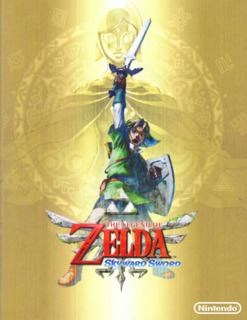Legend of Zelda: Skyward Sword is a unique entry in a fabled series, and for all its imperfections, is a worthwhile game
Game play, 8: The controls are the most radical change in formula for this series. Link (or whatever you name the hero) will perform many actions using motion controls, and this change isn't just a waggle of the remote to swing your sword or pointing it at the screen to shoot a projectile; it is something so much more complicated and new. All of Link's sword movements are motion controlled: his swings, pointing it up skyward, and even simply the direction the tip of it is facing; all motion controlled. You will use it to block with your shield. You will use it to throw objects. You will use it to shoot projectiles. You will use it to fly. You will use it to control your parachute when you jump off your bird (the concept of which I will get into momentarily). And other things. This is all made possible thanks to the motion control plus.
An interesting major change in the game is instead of pausing to switch out an an item, you do it during game play. This is a welcomed change as constantly having to pause to switch items out could become tedious (need I remind anyone about the dreaded Water Temple on Ocarina of time?)
Skyward Sword's world is designed much differently than other Zelda games. You have the sky, which serves as a sort of central hub. It has the central village, portals to the lower world, side quests, and other things. You will travel about this area using your bird. This is similar to sailing the sea in the Wind Waker. The lower world is not as open as you might expect the Hyrule's (or Termina) of the past to be. There is no Hyrule Field; in fact, the three main parts of the land are completely separated on ground. The ground world is littered with puzzles, enemies, and everything you would expect to find in a typical Zelda dungeon, but also elements of the open world such as people and (limited) exploration.
The controls work brilliantly. The combat in this game is among the best in the series, if not the best in terms of depth. Only the most avid opponents of motion control gaming could have complaints about the controls.
The dungeon design is excellent. My only complaint is that they were not more difficult, but since I am someone who has been playing Zelda games since Ocarina of Time, and even overcame the satanic design of Majora's Mask's Great Bay Temple, it would not be very fair to rank on the game too much for that. Same thing for the boss fights. Most of them were pretty good, but due to my experience with the series, I did not struggle with them as well. One thing I cannot put on my experience in Zelda games is the padding this game has. There are parts of this game it seems Nintendo slapped in just to make the game longer. I know we want our games to be long, but putting in useless and boring sections hardly helps the value of the game. The bulk of the padding is backtracking; something fans of Metroid Prime may be familiar with. For people who are not familiar with this concept: backtracking is when a game has you go through an area you previously visited again, but with minor changes to the area to extend the game's value rather than just design whole new areas.
However, the game is still very enjoyable despite the periods of padding thanks to the awesome controls, great world and dungeons design, and amount of things to do.
Presentation: 8. The art style is very nice. I have always seen it as a mixture of Twilight Princess's realistic looking design and Wind Waker's cel-shaded design. The graphics look awesome in the sky, certain parts of dungeons, and when you have a great view far away; however, sometimes in other cases, they are not so great. The main issue being jags and the occasional blurry and poorly detailed texture.
The sound track and sound effects are just great. The music you'll hear while flying, Giraham's theme, boss themes, and many others are memorable tunes that will forever remain in the hearts of fans.
The story is pretty good. It is nice to see the main villain not being Ganondorf/Ganon. The series is basically set centuries before the establishment of Hyrule as a nation. After passing flying school or whatever, Link's friend, Zelda (not even a princess in this game), is taken by a huge monster below the clouds and into the lower world. Link ventures down and sets forth on a huge adventure and blah, blah, blah; you get the picture.
Value: 9. Skyward Sword should take you anywhere from 35 to more than 40 hours to complete. Unfortunately, some of those hours are from padding. The game's value still holds up very well though.
PROS
Charming world
Fantastic controls
Great dungeon design
Great soundtrack
Takes a very long time to complete
CONS
Padding
Sometimes the graphics are not so great
Sky world concept is not as well utilized as it could have been
Skyward Sword is not the best Zelda game you are going to play. It brings many new things to the franchise; some good, some not so much. But for all its imperfections, the Legend of Zelda: Skyward Sword is a great game that I would recommend to most people with the exception of absolute motion control haters and Zelda purists. It brings you the things you love about the Legend of Zelda, and more.

